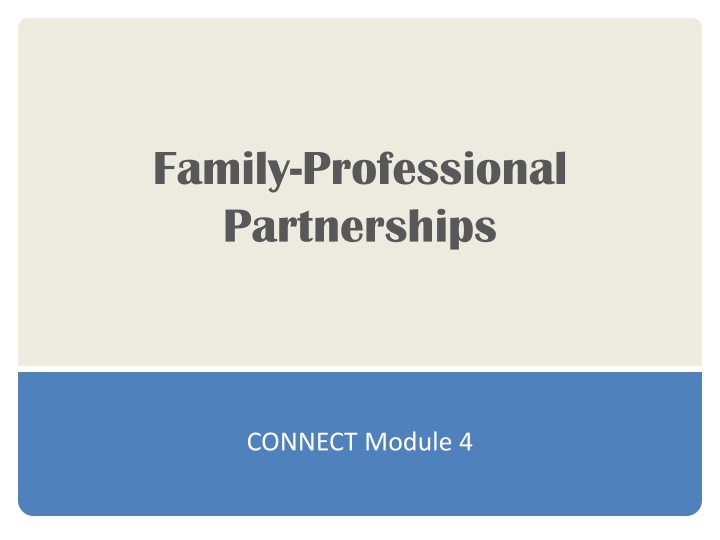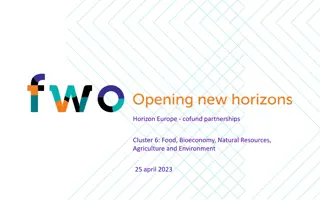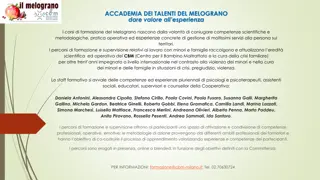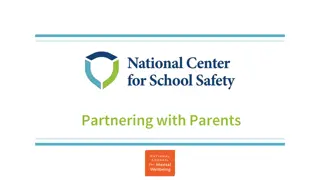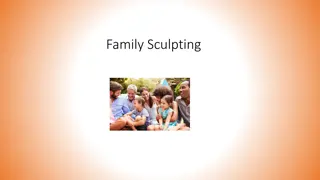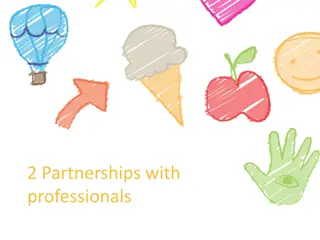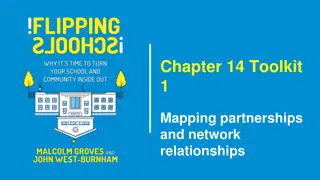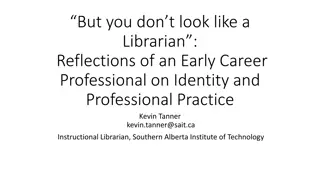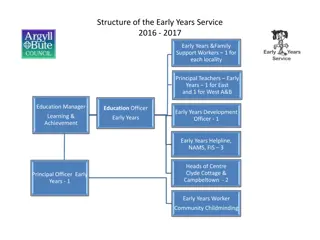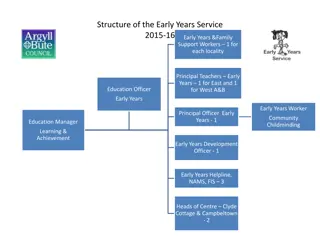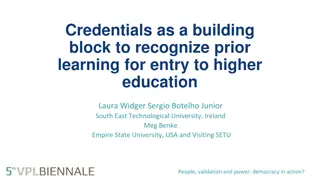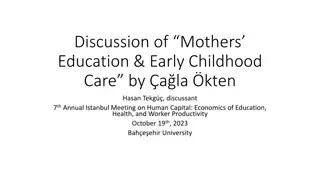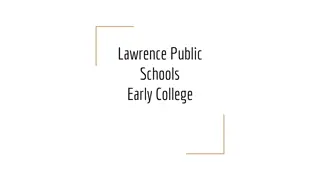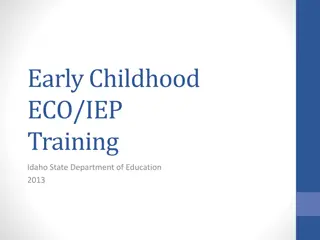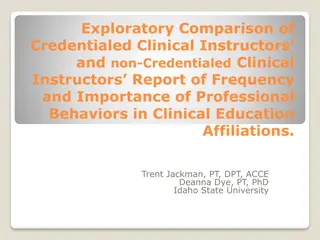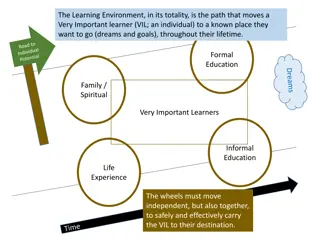Effective Practices for Family-Professional Partnerships in Early Education
This module focuses on developing trusting partnerships between families and professionals in early care and education programs. Learn about decision-making processes for selecting partnership-oriented practices, including building friendly relationships, making shared decisions, and addressing challenging issues with families. Utilize a 5-step learning cycle to understand evidence-based practices for effective family-professional partnerships.
Download Presentation

Please find below an Image/Link to download the presentation.
The content on the website is provided AS IS for your information and personal use only. It may not be sold, licensed, or shared on other websites without obtaining consent from the author.If you encounter any issues during the download, it is possible that the publisher has removed the file from their server.
You are allowed to download the files provided on this website for personal or commercial use, subject to the condition that they are used lawfully. All files are the property of their respective owners.
The content on the website is provided AS IS for your information and personal use only. It may not be sold, licensed, or shared on other websites without obtaining consent from the author.
E N D
Presentation Transcript
Family-Professional Partnerships CONNECT Module 4
Learning Objectives Describe effective practices for developing trusting family-professional partnerships in early care and education programs. Use a decision-making process to select partnership-oriented practices linked to (a) developing an initial friendly relationship, (b) making shared decisions, and (c) developing a trusting partnership with families to address challenging issues. 1. 2. CONNECT
Introduction Welcome to the module on family-professional partnerships developed by CONNECT. This module builds on the basic communication practices you learned in Module 3 and extends to partnership-oriented practices designed to promote trusting partnerships with families. Similar to basic communication skills, partnership-oriented practices require ongoing practice, reflection, and feedback to improve effectiveness in developing trusting partnerships with families. CONNECT
CONNECT 5-Step Learning Cycle You will use a 5-step process taken from evidence- based practice to learn more about partnership- oriented practices between professionals and families. Step 1: Dilemma Consider a dilemma. Step 2: Question Turn the dilemma into an answerable question. Step 3: Evidence Consider key sources of evidence. Step 4: Decision Integrate sources of general evidence, different perspectives, and unique contexts to make an informed decision. Step 5: Evaluation Evaluate the practice decision. CONNECT
Step 1 - Dilemma 5-Step Learning Cycle
Step 1 Module 4 | Step 1 In Step 1 you will hear and read about two perspectives on a practice dilemma. The dilemma is about a teacher sharing a concern with a father of a preschool age child. Meet China. She is a teacher in an NAEYC accredited program that serves children birth through five years of age. China s program is a large full-day community child care center. She has become concerned about Aaron, a four-year-old boy in her classroom.
Video 4.1 Module 4 | Step 1 Video 4.1: The teacher s viewpoint China, a teacher in a large, full-day child care center shares a dilemma about how to express her concerns about little Aaron, a 4-year-old boy in her class, with his father Aaron. (running time: 2 min. 12 sec.)
Video 4.2 Module 4 | Step 1 Video 4.2: The family s viewpoint Aaron, the father of little Aaron, a 4-year-old boy in a preschool classroom, shares his story and goals for his family s future. (running time: 1 min. 37 sec.)
Activity 3.1a Module 3 | Step 1 Now, take a minute to check your knowledge and complete Activity 3.1a: Describe the dilemma
Step 2: Question 5-Step Learning Cycle
Step 2 Module 4 | Step 2 In Step 2 you will turn the dilemma about how to build a trusting partnership into an answerable question to help guide the search for evidence on a particular practice. You can use a tool called PICO to help create a focused question that is answerable through research. PICO identifies the most essential information needed for this question.
PICO Module 4 | Step 2 This information consists of short phrases that can be entered into a web-based search engine to find the best available research evidence on a particular practice such as partnership-oriented practices. PICO requires that you identify the following information to develop the answerable question: P Person (characteristics of the child or family who will receive the intervention) I Interventions being considered C Comparison to other interventions (if there is research that compares two or more interventions) O Outcomes desired
Activity 3.2a Module 4 | Step 2 Use PICO to identify the important information from the dilemma about how to build a trusting partnership with a family and create the answerable question in Activity 4.2a. After you complete Activity 4.2a, view an answerable question related to the dilemma about building a trusting partnership.
Answerable Question Module 4 | Step 2 In working with families of young children in early care and education programs (P), are partnership-oriented practices (I) effective in promoting trusting family-professional partnerships (O)?
Step 3: Evidence 5-Step Learning Cycle
Step 3 Module 4 | Step 3 Step 3 is organized into the following four sections to enable you to consider key sources of knowledge about partnership-oriented practices. Definition Partnership-oriented practices are defined and further explained with examples and activities. Research Best available research on partnership-oriented practices are summarized. Policies Federal legislation and professional guidelines related to partnership-oriented practices are presented. Experience-based knowledge Practitioners and family leaders share their insights and suggestions on the importance of partnership-oriented practices.
A. Definition Module 4 | Step 3 Partnership-oriented practices include: Enhanced communication, high expectations, respect, commitment, equality, and advocacy. Partnership-oriented practices encompass both a child focus and family focus. This means that it is essential to demonstrate partnership-oriented practices in interacting with children and parents. The family focus builds upon a foundation of practitioners being able to demonstrate effective basic communication skills with adults (described in Module 3). The child focus builds upon a foundation of practitioners being able to engage in practices that demonstrate effective teaching. Figure 1 is a Family-Professional Partnership Framework that illustrates this definition.
Figure 1 Module 4 | Step 3
Video 4.3 Module 4 | Step 3 Video 4.3: Description of family-professional partnership framework Dr. Ann Turnbull, Distinguished Professor, Co- Founder and Co-Director of the Beach Center on Disability, describes the family-professional partnership framework to illustrate partnership- oriented practices.
Examples and Applications of Partnership-Oriented Practices Module 4 | Step 3 Trust exists on a continuum, and families are at various points on that continuum when their child starts in an early childhood program. However, a trusting partnership evolves over time rather than happening quickly at the beginning of a relationship. Building trust can be thought of in terms of three phases: Developing an initial friendly relationship Being on beginning ground Making shared decisions Being on middle ground Addressing challenging issues Being on firm ground
Handout 4.1 Module 4 | Step 3 Handout 4.1 includes examples and applications of partnership-oriented practices at each phase. As you go through Step 3 of this module, you will learn about examples and applications at each phase separately. Then you will have a chance to integrate what you have learned across each of the three phases.
Examples and Applications of Partnership-Oriented Practices (cont.) Module 4 | Step 3 The length of time it takes to reach a trusting partnership can vary significantly from one family to another. It is much easier to address challenging issues when you are on firm ground in your relationships with families. In Module 3 you learned that effective basic communication practices require individualization with each practitioner and family, and the same is true for partnership-oriented practices. You will need to adapt the partnership-oriented practices in this module to each family s preferred communication style, cultural considerations, and preferences.
Activity 4.3a Module 4 | Step 3 Take a minute to check your knowledge and complete Activity 4.3: Reflect on your partnerships with professionals
Developing an Initial Friendly Relationship Beginning Ground Module 4 | Step 3 Developing a friendly relationship from the outset requires that practitioners foster comfortable interactions with families, characterized by ease and openness. The development of a friendly relationship occurs as practitioners demonstrate practices aligned with enhanced communication, high expectations, respect, commitment, equality, and advocacy. Watch Video 4.4 of Clara, a practitioner, making an initial home visit with a mother. Then, discuss her initial interactions with families and reflect on her practices to start the relationship off on a positive note. Next, watch the Video 4.5 of Libby, a teacher, and Kim, a parent to Ella, to observe and reflect on examples of practices related to developing an initial friendly relationship (beginning ground).
Handouts Module 4 | Step 3 Handout 4.2: Partnership-Oriented Practices: Observation Checklist Handout 4.3: Partnership-Oriented Practices: Observation Checklist- Answer Key
Video 4.4 Module 4 | Step 3 Video 4.4: Starting a relationship Clara, a practitioner, makes an initial home visit with a mother and describes how to begin a family- professional partnership, especially working with families from different cultural backgrounds.
Video 4.5 Module 4 | Step 3 Video 4.5: Libby and Kim - Beginning ground conversation Libby, a teacher in a child care center, and Kim, a parent of a 4-year-old girl (Ella), have a conversation about working together and learning from one another. This conversation highlights developing an initial friendly relationship.
Activity 4.4a Module 4 | Step 3 Take a minute to check your knowledge and complete Activity 4.4a: Identify video examples of developing an initial friendly relationship (beginning ground)
Making Shared Decisions Middle Ground Module 4 | Step 3 A trusting partnership moves beyond a friendly relationship as practitioners and families have multiple opportunities to interact, exchange information, and share insights with each other in the process of shared decision-making. This evolution of trust occurs as practitioners demonstrate more sophisticated practices aligned with enhanced communication, high expectations, respect, commitment, equality, and advocacy. With the development of trust, conversations and information exchanges are easier and less guarded. This allows for more personal topics to be covered and for more candid exchanges. Watch the video to identify and reflect on examples of practices related to making shared decisions.
Handouts Module 4 | Step 3 Handout 4.2: Partnership-Oriented Practices: Observation Checklist Handout 4.3: Partnership-Oriented Practices: Observation Checklist- Answer Key
Video 4.6 Module 4 | Step 3 Video 4.6: Libby and Kim - Middle ground conversation Libby, a teacher in a child care center, and Kim, a parent of a 4-year-old girl (Ella), have a conversation about working together and learning from one another. This conversation highlights addressing challenging issues.
Activity 4.5a Module 4 | Step 3 Take a minute to check your knowledge and complete Activity 4.5a: Identify video examples of making shared decisions (middle ground)
Addressing Challenging Issues Firm Ground Module 4 | Step 3 A trusting partnership between practitioners and families enables practitioners to address challenging issues in a positive and constructive manner. As trust evolves from middle ground to firm ground, partnership-oriented practices such as enhanced communication, high expectations, respect, commitment, equality, and advocacy become the most sophisticated. Watch the video to identify and reflect on examples of practices related to addressing challenging issues.
Video 4.7 Module 4 | Step 3 Video 4.7: Libby and Kim - Firm ground conversation Libby, a teacher in a child care center, and Kim, a parent of a 4-year-old girl (Ella), have a conversation about working together and learning from one another. This conversation highlights making shared decisions.
Putting It All Together Module 4 | Step 3 You have learned partnership-oriented practices for developing a trusting partnership which involves three phases: (a) developing an initial friendly relationship (beginning ground), (b) making shared decisions (middle ground), and (c) addressing challenging issues (firm ground). Although examples and applications of practices were introduced within these three phases, practices do not always fall into three discrete categories. Lines are often blurred as relationships move in the direction of a trusting partnership. For additional practice, watch the three videos below to identify and reflect on examples of practices related to each of the three phases and developing a trusting partnership.
Video 4.8 Module 4 | Step 3 Video 4.8: Maggie and Latesha - Beginning ground conversation Maggie, a teacher in a child care center, and Latesha, a parent of a 4-year-old boy (Cameron), have a conversation about working together and learning from one another. This conversation highlights developing an initial friendly relationship.
Video 4.9 Module 4 | Step 3 Video 4.9: Maggie and Latesha - Middle ground conversation Maggie, a teacher in a child care center, and Latesha, a parent of a 4-year-old boy (Cameron), have a conversation about working together and learning from one another. This conversation highlights making shared decisions.
Video 4.10 Module 4 | Step 3 Video 4.10: Maggie and Latesha - Firm ground conversation Maggie, a teacher in a child care center, and Latesha, a parent of a 4-year-old boy (Cameron), have a conversation about working together and learning from one another. This conversation highlights addressing challenging issues.
B. Research Module 4 | Step 3 As part of evidence-based practice, families and practitioners can turn to the best available research to answer questions and solve practice dilemmas. The best available research should be current and of high quality, have information about how the practice was implemented and whether it was effective, and be relevant to the situation in the practice dilemma. Terms related to forming trusting partnerships with families are often used interchangeably family-professional partnerships, family-provider relationships, family-centered helpgiving practices, family engagement practices, and family-centered care. All of these terms reflect the importance of the relationship between families and early childhood practitioners. Learn more about the effectiveness research on family-centered helpgiving practices by reading Handout 4.4: Research Summary on Family-Centered Helpgiving Practices. This summary is based on a research synthesis on family- centered helpgiving practices, which are a set of practices similar to the partnership-oriented practices described in this module.
Audio 4.1 Module 4 | Step 3 Audio 4.1: Perspectives of Dr. Beth Harry Dr. Beth Harry, a professor and chair of special education at the University of Miami, discusses the importance of earning the trust of parents from diverse backgrounds through demonstrating respect for their perspectives. Dr. Harry has described the transforming impact of her daughter with special needs on her personal and professional life. She is a nationally recognized leader in research related to cultural diversity within the field of special education, especially on the topic of family-professional partnerships.
Handout 4.4 Module 4 | Step 3 Handout 4.4: Research Summary on Family- Centered Helpgiving Practices
Activity 4.8a Module 4 | Step 3 Take a minute to check your knowledge and complete Activity 4.8a: Apply the research to practice
C. Policies Module 4 | Step 3 In addition to the best available research on family-professional partnerships, you can turn to federal legislation and professional guidelines to answer questions about practice.
Policies Module 4 |Step 3 For this module on family-professional partnerships, information on policy is drawn from two sources: the Head Start Performance Standards and the Individuals with Disabilities Education Act (IDEA). The Head Start Performance Standards include a standard on Family Partnerships (45CFR 1304.40). A central focus of Head Start is to work closely with families to improve the lives of young children. The Family Partnerships standard includes policies directed at engaging in a collaborative partnership-building process with parents, and creating individualized family partnership agreements. For children with identified disabilities, IDEA has as one of its most significant themes an emphasis on parents being equal partners with professionals in making educational decisions about their children. Handout 4.5: Policy Advisory The Law Governing Family-Professional Partnerships summarizes key Head Start Performance Standards and IDEA provisions for Part C (ages birth-3) and Part B (ages 3-21) programs related to families.
Professional Guidelines Module 4 | Step 3 DEC Recommended Practices: A Comprehensive Guide for Practical Application in Early Intervention/Early Childhood Special Education (2005) is the result of an effort that integrated the best available research evidence with knowledge gained through experience in practice. The final set of practices was determined through a consensus process. Within the DEC Recommended Practices, family-professional partnerships are specifically addressed in the Family-Based Practices (F1-F17), and are organized into four categories: Families and professionals share responsibility and work collaboratively, Practices strengthen family functioning, Practices are individualized and flexible, and Practices are strengths and assets-based.
Supplemental Materials Module 4 | Step 3 To learn more about the NAEYC and DEC professional guidelines, and the Head Start Performance Standards, see Supplemental Materials.
Activity 4.9a Module 4 | Step 3 Take a minute to check your knowledge and complete Activity 4.9a: Consider the policy on family-professional partnerships
D. Experience-Based Knowledge Module 4 | Step 3 Earlier you considered two important sources of evidence: the best available research and policies/professional guidelines about family-professional partnerships. Experience-based knowledge is another source of evidence to help guide your decision-making. Experience-based knowledge is the know- how that comes from solving problems, overcoming barriers, and making decisions in everyday life. CONNECT staff identified parents and practitioners from around the country who have experienced-based knowledge on the topic of family-professional partnerships and invited them to share their views. Now listen to audio clips from phone interviews with these spokespersons and identify important considerations to keep in mind about developing trusting partnerships.
Audio 4.2: Janice Fialka Module 4 | Step 3 Janice and her husband have two wonderful adult- children, Micah and Emma. They love to laugh together, travel, and discuss social justice issues at the kitchen table. Janice is a social worker, national speaker, author, and is active in the disability justice movement. She is also the Special Projects Trainer for Early On (Michigan's Part C Training and T.A. system). Micah is one of the new wave of adults with intellectual disabilities who attend college. To learn more about Janice and Micah's work, go to www.danceofpartnership.com and www.throughthesamedoor.com.
Audio 4.3: Samtra Devard Module 4 | Step 3 Samtra resides in Bear, Delaware, with her husband and their three children, one of whom has a disability. Samtra is the founder of the HOPE Center Network for Families which operates under the core belief that Every Child Has Possibilities . Samtra is a devoted advocate for children and their families and is particularly interested in advocating for systems change. She is a parent leader in numerous national and state organizations and initiatives, as well as a writer and speaker at workshops and conferences nationwide. Samtra holds a Bachelor of Science degree in Chemical Engineering from Drexel University. Learn more at about the HOPE Center Network for Families at www.hopecenterofde.com.
